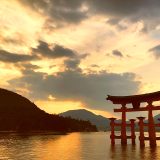[Iwakiyama Shrine summary]
Iwakiyama Shrine is located in Hirosaki City, Aomori Prefecture, at the foot of Mt. There are various theories about its founding, but it is believed that the shrine was built on the summit of the mountain in the 11th year of the Hogame Era (780). The shrine was destroyed by fire during the eruption of Mt. Iwaki in 1589, but was rebuilt by Tsugaru Tamenobu in 1603. Since ancient times, the shrine has been a guardian deity of agriculture and fishery, a pioneer god of Tsugaru, and a place where the ancestral spirits of the local people are enshrined.
The deities are Utsushikunitama no Kami, Tatsuhime no Kami, Uganome no Kami, Oyamazumi no Kami, and Sakanoue no Karitamaro no Mikoto.
【Mt. Iwaki】
![Iwakiyama Shrine [Aomori] iwakisan1 1024x683 - Iwakiyama Shrine [Aomori]](https://japan-shrine.info/wp-content/uploads/iwakisan1-1024x683.jpg)
Mt. Iwaki is one of Japan’s 100 most famous mountains, standing 1,625 m above sea level, and is the highest peak in Aomori Prefecture and a symbol of the Tsugaru Peninsula, centered in Hirosaki City. It is also called Tsugaru Fuji because of its shape, and is beloved by the local people. Iwakiyama Shrine is known as the head temple of the Mt. Iwaki faith and is widely worshipped.
【Iwakiyama Shrine scenery】
![Iwakiyama Shrine [Aomori] DSC 0203 1024x768 - Iwakiyama Shrine [Aomori]](https://japan-shrine.info/wp-content/uploads/DSC_0203-1024x768.jpg)
The first torii gate is white. It is about 300-400 meters from this torii to the main hall.
![Iwakiyama Shrine [Aomori] DSC 0205 1 1024x768 - Iwakiyama Shrine [Aomori]](https://japan-shrine.info/wp-content/uploads/DSC_0205-1-1024x768.jpg)
The long stone pavement that stretches in a straight line from the first torii gate to the tower gate is magnificent. The approach that continues straight all the way to the hall of worship, and even to Mt. The approach to the shrine offers a variety of views depending on the season. During the season of fresh greenery, both sides of the path are covered in green, and the rows of large trees add to the atmosphere of the path.
【Iwakiyama Shrine precincts】
![Iwakiyama Shrine [Aomori] DSC 0209 1 1024x768 - Iwakiyama Shrine [Aomori]](https://japan-shrine.info/wp-content/uploads/DSC_0209-1-1024x768.jpg)
The precincts of the shrine include the main hall, which is designated as a National Important Cultural Property, a regent shrine, and the shrine office. The shrine pavilions retain vestiges of the Shinto/Buddhist syncretism period, and while the structure is reminiscent of an esoteric Buddhist temple from the Kamakura period (1185-1333) onward, the colorful carvings are reminiscent of the Momoyama period (1573-1600).
【Iwakiyama Shrine Tower gate and worship hall】
![Iwakiyama Shrine [Aomori] DSC 0212 1024x768 - Iwakiyama Shrine [Aomori]](https://japan-shrine.info/wp-content/uploads/DSC_0212-1024x768.jpg)
The tower gate is a magnificent structure. It was built in 1628.
![Iwakiyama Shrine [Aomori] DSC 0222 1 1024x768 - Iwakiyama Shrine [Aomori]](https://japan-shrine.info/wp-content/uploads/DSC_0222-1-1024x768.jpg)
The shrine pavilions are colorfully carved and gorgeous, as if they were called Oku-Nikko.
![Iwakiyama Shrine [Aomori] DSC 0225 1024x768 - Iwakiyama Shrine [Aomori]](https://japan-shrine.info/wp-content/uploads/DSC_0225-1024x768.jpg)
There is a water fountain on the right side of the gate. The water is said to be melted snow from Mt.
![Iwakiyama Shrine [Aomori] DSC 0222 1 1024x768 - Iwakiyama Shrine [Aomori]](https://japan-shrine.info/wp-content/uploads/DSC_0222-1-1024x768.jpg)
The central gate has a ceiling painting of a dragon god, and we encourage you to look up.
![Iwakiyama Shrine [Aomori] DSC 0219 1024x768 - Iwakiyama Shrine [Aomori]](https://japan-shrine.info/wp-content/uploads/DSC_0219-1024x768.jpg)
The hall of worship is a vermilion-colored structure that retains the vestiges of the Shinto-Buddhist syncretism. A large bale is decorated as a sacred rope.
![Iwakiyama Shrine [Aomori] IwakisanShrine3 1 1024x768 - Iwakiyama Shrine [Aomori]](https://japan-shrine.info/wp-content/uploads/IwakisanShrine3-1-1024x768.jpg)
Iwakiyama Shrine holds annual events such as the regular festival, spring festival, and autumn festival, which attract many people from within and outside of the prefecture. The regent shrines are dedicated to Empress Jingu and Sugawara Michizane. The shrine office displays materials related to the Iwakisan faith, as well as sacred objects used at the Iwakiyama Shrine.
【Iwakiyama Shrine GOSHUIN】
![Iwakiyama Shrine [Aomori] 2024 10 03 11 45 Office Lens 771x1024 - Iwakiyama Shrine [Aomori]](https://japan-shrine.info/wp-content/uploads/2024_10_03-11_45-Office-Lens-771x1024.jpg)
【Iwakiyama Shrine Nearby attractions】
Mt. Iwaki,Shirakami Mountains, Hirosaki Castle
[Iwakiyama Shrine Access]
Access toIwakiyama Shrine is a 30-minute drive from JR Hirosaki Station. Buses are also available from Hirosaki City. Parking is available, but public transport is recommended as the shrine becomes crowded during the annual festival and autumn festivals.
Manager’s Comments
I have visited the shrine many times because it is my hometown, and I think the scenery of seeing cherry blossoms and snow at the same time is very wonderful and mysterious. The shrine is also known as Tsugaru Fuji, which is a symbol of the Japanese belief in the unity of Mount Iwaki and the mountain. The shrine has been selected as one of the 100 best shrines in Japan, and I hope you will stop by when you come to Aomori.
27 Terasawa, Momosawa, Hirosaki-shi, Aomori 036-1343
Parking lot for worshippers available.
 Tour of Japanese shrines and temples
Tour of Japanese shrines and temples 

![Iwakiyama Shrine [Aomori] 23245878 m 520x300 - Iwakiyama Shrine [Aomori]](https://japan-shrine.info/wp-content/uploads/23245878_m-520x300.jpg)
![Iwakiyama Shrine [Aomori] DSC 0254 2 520x300 - Iwakiyama Shrine [Aomori]](https://japan-shrine.info/wp-content/uploads/DSC_0254-2-520x300.jpg)
![Iwakiyama Shrine [Aomori] 3d2b96c2682ade831707ffe9118497d4 - Iwakiyama Shrine [Aomori]](https://japan-shrine.info/wp-content/uploads/sng/3d2b96c2682ade831707ffe9118497d4.jpg)
![Iwakiyama Shrine [Aomori] 23245878 m 150x150 - Iwakiyama Shrine [Aomori]](https://japan-shrine.info/wp-content/uploads/23245878_m-150x150.jpg)
![Iwakiyama Shrine [Aomori] DSC 0308 150x150 - Iwakiyama Shrine [Aomori]](https://japan-shrine.info/wp-content/uploads/DSC_0308-150x150.jpg)
![Iwakiyama Shrine [Aomori] IMG 2777 150x150 - Iwakiyama Shrine [Aomori]](https://japan-shrine.info/wp-content/uploads/IMG_2777-150x150.jpg)
![Iwakiyama Shrine [Aomori] DSC 0207 150x150 - Iwakiyama Shrine [Aomori]](https://japan-shrine.info/wp-content/uploads/DSC_0207-150x150.jpg)
